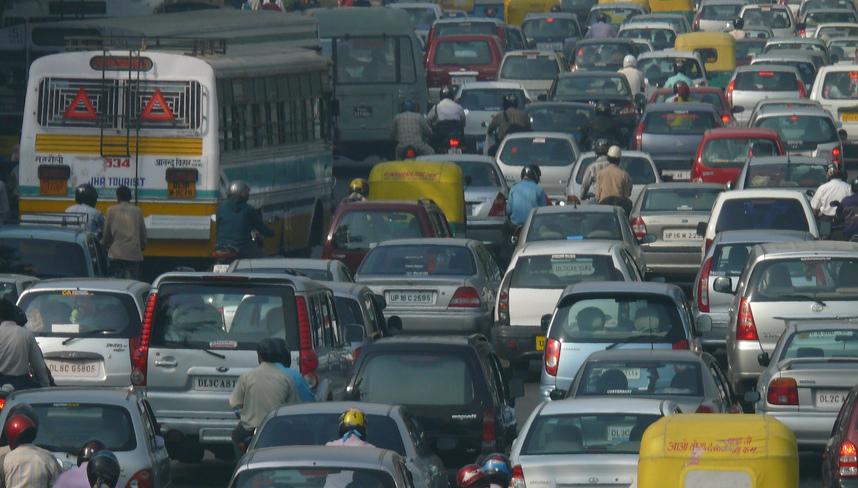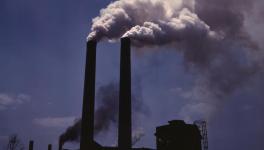Leapfrogging to Stage VI Vehicular Emission Norms

Vehicular Pollution, Image Courtesy: wikipedia.org (originally posted to Flickr by N-O-M-A-D at http://flickr.com)
The government finally issued the long awaited gazette notification for the sharply compressed timetable for introduction of Bharat Stage VI (BS-VI) emission norms for vehicles and other petroleum combustion engines, broadly conforming to the Euro VI emission norms. Government had earlier released an almost identical draft of this policy in January 2016 and had given all stakeholders time to respond.
Currently and as of 2010, Bharat State IV (BS-IV) emission norms prevail in 13 metropolitan and other major cities, while the less stringent Bharat Stage III norms prevail in the rest of the country. The new policy skips several steps, notably the entire Stage V norms earlier scheduled for 2019, and stipulates a nationwide roll out of BS-VI norms by April 1, 2020, sharply advancing the date from the earlier envisaged 2024. This is a significant policy move that will substantially reduce vehicular air pollution in India, and call for major technological changes in the automobile sector covering the entire range of vehicle types, as also in diesel generators and other petroleum combustion devices, with consequent impact on costs and prices of both devices and fuels. This rise in prices, however, will be more than offset by the enormous benefits from lower air pollution which is estimated to have caused around 6 lakhs premature deaths in 2010 and related health care costs of around 3% of GDP.
The policy puts considerable pressure on the automobile industry to rapidly make the requisite technological changes to enable meeting the new emission norms, and also on the petroleum industry to ensure a nationwide roll-out of gasoline and diesel conforming to the new, higher standards, all in the next four years.
The new policy comes in the wake of the national and international spotlight especially in the past two years on extraordinarily high air pollution in Indian cities, caused mostly by vehicular sources, notoriously bringing most Indian metros and major cities to the front ranks of the most polluted cities of the world. In the wake of several adverse reports by many national and international agencies, the Delhi government had even imposed the odd-even restrictions on personal vehicles in the capital last winter under which roughly half the vehicles were taken off the roads depending on the odd or even last digit in their number plates. The intense nationwide debate, the embarrassing worldwide attention, and the calls for action by experts, the citizenry and the Supreme Court, had pushed the government to take strong and urgent action, paving the way for the new policy and helping to overcome strong resistance from the automobile and petroleum industries.
New emission standards BS-VI norms call for stringent tailpipe emission limits especially for diesel vehicles, sharply narrowing the differential between gasoline and diesel vehicles. For instance, while carbon monoxide (CO) norms are unchanged for petrol vehicles, the norms for nitrogen oxides (NOx) are considerably tightened from 80-110 mg/km (milligrams per kilometer) for different weight classes to 60-82 mg/km. NOx gases contribute to acid rain, dangerous surface-level and lower-atmosphere ozone, and to smog notably in the presence of sunlight. Smog causes lung damage and lung diseases such as asthma, and those who work outdoors, have lung ailments and children are particularly susceptible.
Norms for diesel vehicles are significantly tightened in BS-VI compared to BS-IV. NOx limits are tightened to 80-125 mg/km in BS-VI compared to 250-390 mg/km in BS-IV. There is also a drastic lowering of limits of particulate matter (PM), which were so much in focus during the odd-even debate in Delhi last winter. PM limits in BS-VI are a markedly low 4.5mg/km for all classes of vehicles compared to 25-60 mg/km for the three broad vehicle classes in BS-IV.
It is important to note that tight BS-VI norms are also specified for 2 and 3-wheeler petrol and diesel vehicles.
These norms will call for several modifications and additional fitments in virtually all types and classes of vehicles as discussed further below, calling for major restructuring of the relevant industries and a rise in costs to the consumer.
As would be appreciated, quality of the fuel used has a close correlation with the resultant emissions after combustion in the engine. Therefore, correspondingly stringent norms have also been specified for different fuels under BS-VI. Fuels to this standard should be available throughout India again by 2020.
Fuel Standards For petrol, a Research Octane Number (RON), a measure of the energy content of the fuel and its ignition quality and “knocking” properties, has been retained at 91 with a provision of 95 for premium fuel used in most larger or high-end vehicles. Lead continues with a specified maximum of 5mg/l (milligrams per litre), the same level as prevalent under BS-IV in the major cities and BS-III in other parts of the country.
Sulphur content of both petrol and diesel has been specified at a low 10 ppm (parts per million), a level used to define ultra low sulphur diesel (ULSD) first in Europe and then in North America. Low sulphur content in fuel helps in lowering particulate matter and hence is considered as especially important for lowering air pollution levels. In India, BS-IV sulphur standard is 50ppm currently applicable in the 13 major cities and fuel to this standard should be available throughout the country by 2017 where currently BS-III standard of 150ppm is being supplied.
This will call for additional refining by oil companies which will have to update their plants and incur additional cost estimated at around Rs.30,000 crores.
In the period since the notification of the draft BS-VI standards in January 2016, there has been acrimonious debate between the oil and automobile industries. The latter have been raising serious concerns about the oil companies making BS-VI standard fuel by the roll-out date of 2020, without which their vehicles would not be able to deliver the desired tailpipe norms.
More seriously, the automobile industry had also raised a hue and cry about low standards having been specified for fuel, while demanding high standards from vehicles. The always aggressive and influential Society for Indian Automobile Manufacturers (SIAM) alleged that the BS-VI fuel standards were “highly diluted” compared to Euro VI and that they would take India back to BS-II emission levels! SIAM stridently demanded that fuel standards should be “exactly” equivalent to Euro-VI if those tailpipe standards were being demanded from vehicles in India, which too, they claimed, put an enormous burden on the automobile industry.
SIAM were clearly over-reacting as they always do! As rightly pointed out by oil industry spokespersons, BS-VI also specified 95 Octane for premium fuel used by all vehicles except the smallest, and which is not relevant for 2 and 3-wheelers, which constitute around 70% of vehicles on Indian roads and consume around 60% of the fuel. Further, Octane Number is not directly correlated to emissions but rather to engine performance and efficiency.
Technological challenges To be sure, there are challenges to be faced by both vehicle manufacturers and the oil industry.
Petrol vehicles will have lesser burden than diesel vehicles which have to make a significantly greater leap in emission standards and, given the nature of the latter engines, will have to introduce many new technologies.
Petrol vehicles can conform to the new BS-VI standards by changes in the engine’s air-fuel system and in the exhaust system through exhaust gas recirculation.
Diesel vehicles would have a far tougher and more expensive task, which is only fair and necessary since they are far worse polluters. They would need new equipment such as NOx Traps, Catalytic Converters that reduce exhaust pollutants especially NOx and which already exist in many petrol vehicles in India, and Diesel Particulate Filters (DPF) for the dangerous PM emissions. The latter are probably the most problematic, especially since they would have to be adapted to Indian conditions. DPFs are cylindrical attachments that sit inside the engine compartment. Given the relatively small size of cars in India, including even diesel vehicles, this would require spatial adjustment or even expansion under the bonnet while keeping the vehicle length within limits so as not to cross over to the higher tax bracket. DPFs burn off soot particles, calling for temperatures of around 600 degrees C, which may be difficult to achieve in slow-moving traffic conditions in India especially in crowded cities, therefore the equipment may have to be modified to perform equally well at lower temperatures.
In order to achieve all this, engine performance has also to be tightly monitored and controlled by automatic computer controls. Obviously, the role of sensors, electronic controls and micro-processors inside vehicles will rise quite substantially. The days of amateur drivers hunched over open bonnets are clearly over! And road-side mechanics will find it extremely difficult to cope with the advanced technologies inside such vehicles, so India will see less and less of this already diminishing breed!
Testing and standardizing all these equipment and modifications under Indian conditions would also have to be done inside a compressed time schedule given the 2020 deadline for the roll-out.
Automobile industry sources estimate that all these changes would require an additional investment of around Rs.50,000 crores.
Once again, SIAM and various industry spokespersons have been complaining about all these changes, and how difficult and expensive they are going to be. It bears remembering that when fuel efficiency norms were finally announced in 2014, after more than five years of vigorous SIAM stonewalling and lobbying against them, then too SIAM had protested that the norms were too tight, and that they would pose a huge burden on the car industry!
One can understand SIAM, like any other industry association, stoutly defending the interests of their industry. But automobile manufacturers in India, which despite a competitive environment is doing well compared with other industries in the country, have several advantages which should enable them to tackle such advances demanded of them vis-à-vis efficiency or emissions. Most manufacturers in India are MNCs and the others too have sound access to the latest technologies, so that should not be a worry. Complaints about rising prices of their products are also unfounded since these prices will be passed on to consumers by all manufacturers and will therefore have only a transitory effect if any, despite the notorious price sensitivity of the Indian automobile market. And many manufacturers are already making export models conforming to Euro-VI standards! There is little reason for so much moaning and groaning by such a well-off and flourishing industry which hopes to be a global hub sooner rather than later, especially when it is all for the broader societal good.
Disclaimer: The views expressed here are the author's personal views, and do not necessarily represent the views of Newsclick
Get the latest reports & analysis with people's perspective on Protests, movements & deep analytical videos, discussions of the current affairs in your Telegram app. Subscribe to NewsClick's Telegram channel & get Real-Time updates on stories, as they get published on our website.
























